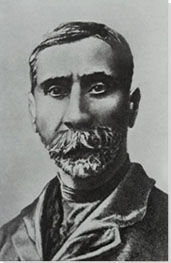Summary of Niko Pirosmani
Posthumously celebrated Georgian painter Niko Pirosmani was a true artist's artist and a prime example of the starving artist archetype. Self-taught, he used his life in the progressive country of Georgia as fodder to create works illustrating the customs, traditions, environments, and culture of his native land. Using cheap materials and a neutral palette, he documented his world using folk art traditions to inform a unique visual aesthetic. Though his lifetime never saw monetary success or widespread fame, he managed to make enough to consistently supply him with materials from which to create a prolific body of work. He is now seen as an important contributor to the Russian avant-garde, particularly the Neo-Primitivist and Rayonist movements.
Accomplishments
- The artist began his career painting signs for local businesses as advertisements for their wares, where he learned to work fast on commission. Deeply committed to remaining creative at all costs, these signs allowed Pirosmani to buy art supplies to create his fine art paintings and kept his work positioned in the public eye, leading to his status as a hometown hero.
- Pirosmani's oeuvre is a remarkably precious glimpse of the Georgian lifestyle, heritage, and experience of the late 1800s and early 1900s. His paintings provide a solid, historical time capsule of the country's union of traditional rural life and its evolution into a more cosmopolitan locale. Because of this, the artist found champions in many members of the entitled classes of the time, who recognized his talent and ability to capture the period's cultural cross section of the old with the new.
- Pirosmani is often coined a Naïve artist, or one who lacks a formal artistic education or training. This allowed him to birth his own signature style, which was dynamic, organic, and truly original, setting him apart from other painters of his time. Like Henri Rousseau before him, his brand of vagabond creativity would set the stage for later artists, working in the same primal fashion, eventually leading to the formation of art movements such as Art Brut and Outsider Art.
Important Art by Niko Pirosmani
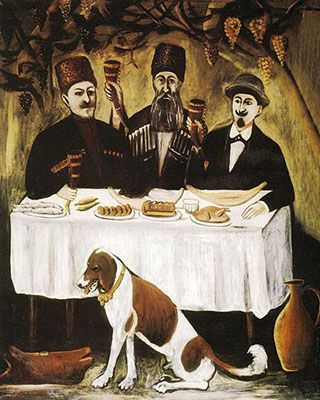
Feast in the Grape Pergola or Feast of Three Noblemen
This painting depicts three Georgian noblemen at a feast table, toasting goblets of wine and eating traditional dishes. In the foreground sits a dog, while in the background plentiful vines hang above the feast-goers. Painted in Pirosmani's usual neutral palette, the style features a flatness and lack of depth typical of the Naïve artist. The brushstrokes, particularly in the background, demonstrate how Pirosmani painted in a rapid and dynamic way in order to capture the simplicity of the everyday lives and traditions of the Georgian people.
Pirosmani's unique visual vocabulary and traditional subject matter, unconnected to the artistic trends taking place in Moscow and Paris, as well as his impoverished living conditions and local status, set him apart from other artists of this time. Paintings such as Feast in the Grape Pergola, caught the eye of the Russian avant-garde artist Mikhail Larionov, who became a steadfast champion of Pirosmani's, and both the subject matter and style can be seen as having informed Larionov's later works. The artist painted street scenes, such as A Stroll in a Provincial Town (c.1909), in a similar flat, non-perspectival manner to Pirosmani.
Oil on cloth - Art Museum of Georgia, Tbilisi, Georgia
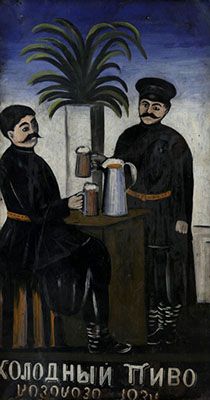
Signboard 'Cold, Cold Beer'
This work is characteristic of the signboards Pirosmani was commissioned to make for the local taverns in Tbilisi. It was painted on tin due to the metal's cheapness, but also because it could be hung outside in any weather. The sign's text translates to "Cold, Cold Beer;" a message illustrated by the two typically and identically dressed Georgian men at the table enjoying a jug. The tree in the background suggests that they are drinking outside.
The simplicity of signboards such as Cold, Cold Beer captured the imagination of Le Dantu and the Zdanevich brothers when they traveled to Tbilisi. The simple color palette was chosen as dark paints were easily obtainable and inexpensive, but the effect they created - the pictorial flatness, the simple outlines, and the boldness - found resonance with the vision and ideas of the developing avant-garde in Moscow. Art historians Alla Povelikhina and Yevgeny Kovtun have argued that the artist's signboards differed from those of contemporary Russian painters, writing, that "by comparison, Pirosmani is closest to Henri Rousseau, except that Pirosmani relied on the heritage of Georgian and Persian art."
Pirosmani was a main influence in using simple art scenes of everyday life to illustrate advertising concepts. The style would become widely seen in Russia shortly after the revolution of 1917.
Oil on tin - Art Museum of Georgia, Tbilisi, Georgia
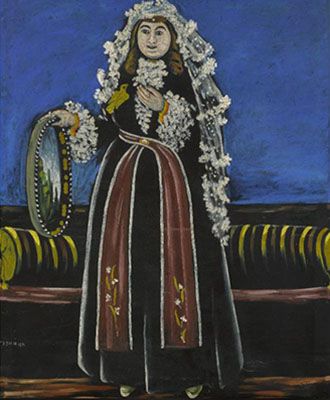
Georgian Woman Wearing a Lechaki
The composition is simple, featuring a woman who takes up the whole canvas from top to bottom, and is set against an unknown landscape background. The materials are signature to those that Pirosmani used throughout his life: readily available paint colors and anything easily on hand as an improvised canvas, such as tablecloths from the taverns at which he was working.
This painting is another prime example of Pirosmani's depiction of everyday scenes in Georgian life.
It is one in a series of paintings illustrating women in traditional Georgian dress; it is set apart from the series by the inclusion of the bird on the dress lapel and the intricacy of the floral lace on Lechaki, with matching cuffs and neckline on the dress. The equation of women with nature was a common theme in both Georgian folklore and Pirosmani's paintings. This painting was previously in the collection of the Austrian author Stefan Zweig, who became familiar with the work of Pirosmani during a 1928 visit to Moscow. Zweig's late discovery of Pirosmani is a clear example of how the artist only really achieved widespread recognition posthumously. The writer was an enthusiast and keen collector of Primitivist art, and following his discovery of Pirosmani's work at an exhibition in the State Tretyakov Gallery described the artist as "the great Piro" and predicted his work would be a "true discovery for Europe."
Oil on cloth - Private Collection

Roe Deer Drinking From A Stream
In Roe Deer Drinking From A Stream a deer fills the frame much like in the artist's portraiture. The work is painted in Pirosmani's standard oil paint palette of dark greens, blacks, and browns, and was completed using quick brushstrokes against a cardboard canvas. It was featured in the Target exhibition of 1913.
This painting demonstrates Pirosmani's preoccupation with nature and rural life, particularly that which was native to his Georgian home. Like many folk artists before him, the juxtaposition of nature with everyday life was an important motif for him. The deer could be seen as an example of innocence amongst a changing country moving toward progress much like the own artist's role in the rising art scene of the time that contributed to evolving the Russian avant-garde.
The painting was previously hung in The White Dukhan tavern in Tbilisi. It was one of many works that the artist completed for local patrons in exchange for food, drink, or lodgings. The Georgian actor Tamar Tsitsishvili, who instantly acknowledged it as a work by Pirosmani, purchased it in 1949, and it remained in her family for 50 years. This purchase highlights the devotion that the Georgian audience had for Pirosmani.
The painting's status as an immediately recognizable and highly characteristic Pirosmani work is reflected in the fact that it sold for just over $500,000 at auction in 2011, to Georgia's former Prime Minister Bidzina Ivanishvili, who donated it to the Art Museum of Georgia in Tbilisi.
Oil on cardboard - Art Museum of Georgia, Tbilisi, Georgia
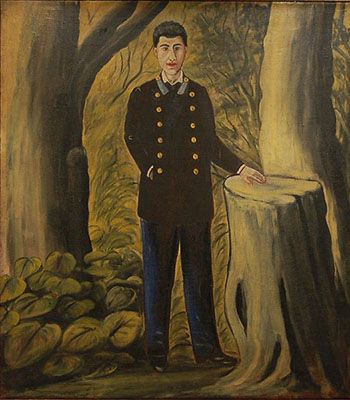
Portrait of Ilya Zdanevich
As in his other portraits, Pirosmani uses the full height of the canvas to portray his subject; in this case, the poet and avant-garde advocate Ilya Zdanevich. Like other depictions of Georgian figures painted by the artist at this time in his career, the protagonist is painted flatly against a background, which is not distinctly recognizable, but definitely rural. The dark colors are typical of Pirosmani's work, as is the cheap material on which he painted: in this case cardboard. What differentiates the portrait is that the figure is clearly not Georgian in his dress: he is a Russian subject painted in a traditionally Georgian manner.
Pirosmani's meeting with Ilya Zdanevich in the early 1910s changed his career significantly. An enthusiastic promoter avant-garde art, Ilya Zdanevich and his brother Kiril discovered Pirosmani's work in the taverns of Tbilisi. They took a small collection of works with them to Moscow to feature in the Target exhibition in Moscow in 1913, the same year the artist painted this portrait. In Moscow, for the first time the artist's works had a public audience beyond the patrons of the bars and restaurants of Tbilisi. It also put his paintings in front of the eyes of key members of the Russian avant-garde, such as Mikhail Larionov and Natalia Goncharova. Following the Target exhibition, Pirosmani was invited to join the Society of Georgian Painters and was included in numerous publications in Russia and Georgia.
Oil on cardboard - Private Collection
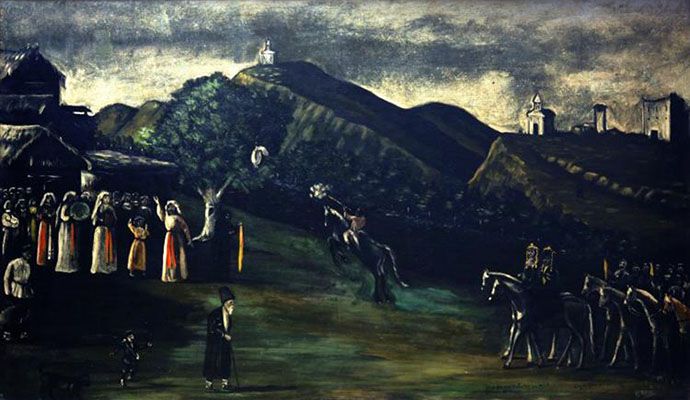
Wedding in the Old-Times Georgia
Wedding in the Old-Times Georgia depicts a traditional wedding taking place in rural Georgia. The is the first time we see the artist working on a large landscape scale, having usually painted single or small group portraits. The background is more detailed than Pirosmani's previous works, and illustrates dark hills, a distant village, a church, and thatched farm buildings. In the foreground, a group of celebratory wedding guests dressed in traditional costume greet passers-by on horses. The appreciation of Georgian customs is highlighted in the foreground, where a small boy stands behind an old man walking towards the horses.
One of the most ambitious works by Pirosmani, it was painted using funds the artist received from the Society of Georgian Painters. This can perhaps be viewed as the most financially lucrative moment of the artist's career. However, his naïve style and lack of formal artistic education was mocked by some members, resulting in his leaving the Society a short time later. This painting can therefore be seen as a turning point in his career, in which he may have continued on within the Society to receive future commissions and financial gain, yet remained true to his personal style and ambitions as a lone wolf unconfined by formal artistic conventions.
Oil on cloth - Art Museum of Georgia, Tbilisi, Georgia
Biography of Niko Pirosmani
Childhood
Niko Pirosmani was born in the village of Mirzaani in the Kakheti region of eastern Georgia in 1862. At the time, Georgia was on a large trade route between East and West: an interesting junction which produced a myriad culture combining elements from Christianity and mainland Europe, as well as the Mediterranean, Byzantium, and the Orient. It was also a place of folkloric tales and deeply engrained traditions and rituals.
Pirosmani's parents, Aslan Pirosmanashvili and Tekle Toklikishvili, were, like the vast majority of rural Georgians, farmers. They owned a small vineyard and farm animals. Pirosmani was orphaned early in life and left under the guardianship of his two elder sisters. In 1870, following their parents' deaths, the siblings moved to Tbilisi in search of work. Pirosmani took up employment as a servant in the house of a wealthy family, before working as a railroad conductor, and later a dairy farmhand in order to make a living and pay for art equipment.
Early Training and Work
While working in Tbilisi, Pirosmani taught himself how to paint and supplemented his income by creating shop signs and paintings in taverns and restaurants. These works referenced the mixed culture of Georgia in subject and technique: the artist incorporated elements of his own rustic heritage and experience, and painted directly onto readily available materials, such as oil cloth. Given the sparsity of materials, Pirosmani learned to paint quickly, which made his style dynamic and organic.
In 1882, the artist opened a painting workshop with his friend and fellow painter George Zaziashvili, where the duo made signboards for local businesses. Their work was influenced by the social conditions they faced, the occupations of their patrons, and everyday scenes in Tbilisi. The signs and paintings featured merchants, scenes of animals and rural life, as well as historical stories and Georgian myths.
Mature Period
It was not until the 1910s that Pirosmani's work reached a wider audience. The Russian poet Mikhail Le Dantu, accompanied by the artist Kiril Zdanevich and his poet brother Ilya, discovered Pirosmani's work in a tavern in Tbilisi. Although the exact date of this encounter is unknown, it is clear that by 1913, poet and avant-garde advocate Ilya Zdanevich was writing about Pirosmani in the newspaper Zakavkazskaia Rech and promoting his art in Moscow. Four of Pirosmani's paintings were presented in an exhibition of self-taught painters in Moscow in January of that year, including Portrait of Ilya Zdanevich, and were positively received by critics. Later that year, an article about the artist was published in the Georgian newspaper Temi.
Through Le Dantu and the Zdanevich brothers, Pirosmani's work became increasingly noticed and caught the eyes and imagination of the up-and-coming Russian avant-garde artist couple Mikhail Larionov and Natalia Goncharova. The couple looked to naïve and primitive art and the work of folk artists for inspiration. They were so taken with Pirosmani's work that they wanted to include a few pieces in their seminal exhibition Target in Moscow in 1913. Larionov asked Ilya Zdanevich for works by "the charming and remarkable Niko Pirosmani (we've come to love them so much), along with some of his wonderful signs."
By exhibiting in the same circles as Larionov and Goncharova, Pirosmani helped to validate the new wave of Russian artists as separate from the European avant-garde. The inclusion of such an untrained folk artist and homegrown local personality, who was deeply committed to creating art despite no formal training, reinforced the idea that their art could represent both high culture and lowbrow art. His work reflected the unique culture of Georgia and Russia in its marriage of tradition with modernity and its juxtaposition of rural life with the growing cosmopolitan city. In this way, Pirosmani's art began to reach beyond the shopfronts of Tbilisi.
In 1916, Ilya Zdanevich organized a one-man show for Pirosmani in Tbilisi, which opened to good reviews. Following these exhibitions and the increasing interest in his work in Moscow, Pirosmani was approached to join the Society of Georgian Painters in 1916. The Society's founder, Dito Shevardnadze, personally invited Pirosmani to meetings and arranged much-needed funding for the artist. However, this relationship with the Society did not last. After a negative cartoon depicting the artist was published by members of the Society, along with general whisperings about his lack of education and training, he severed all ties.
Throughout this decade of his life, despite some successes, Pirosmani remained in poverty. Usually homeless, he painted mostly in exchange for food and wine, spending what money he made on art supplies. As well as his technique and style, it was this devotion to art that caught the imagination of members of the Russian avant-garde.
Late Period
Pirosmani did not live to see any success further than his exhibitions of the 1910s. Although his work had started to become known throughout Georgia and Russia, he was not financially well-off. Combined with the economic effects of the outbreak of the First World War, poverty had a dire effect on the artist's health. Pirosmani died from malnutrition and liver failure in the cellar of a tavern in Tbilisi at the age of 55.
The Legacy of Niko Pirosmani
In the immediate aftermath of his death, local artists such as Lado Gudiashvili and David Kakabadze celebrated Pirosmani by creating frescoes in the taverns, cafes, and restaurants of Tbilisi. From 1920 onwards, due to the continued work of the Zdanevich brothers, Pirosmani's work became increasingly more well-known. Articles were published about him in Georgia, Russia, and France. Kiril Zdanevich published the first monograph on the artist in 1926, which was translated into Russian and French, followed by a larger monograph in 1963.
Despite his lack of recognition and financial success during his lifetime, Pirosmani has become viewed as a key figure in the development of the Russian avant-garde, particularly the Neo-Primitivist and Rayonist movements. This is perhaps most clearly demonstrated in the effect his work had on Larionov and Goncharova. These artists looked to the past and peasant life to discover a new way of painting in terms of style and subject. They renewed an interest in the style of shop signs and tavern paintings, and in using the themes seen in everyday life.
Pirosmani's use of traditional rural themes and search for the primitive can also be seen as influencing the work of Kazimir Malevich, David Burliuk, and Marc Chagall. Outside of Russia and Georgia, Ilya Zdanevich spent a large portion of his life in Paris. He took with him catalogues of Pirosmani's work, which he shared with avant-garde artists in France. In particular, Pablo Picasso was intrigued by the work of Pirosmani, appreciating the unique perspective that his rural roots brought to his art. Picasso was so taken with Pirosmani that he sketched a portrait of the artist in 1972. Pirosmani's influence reaches the art world today, finding admirers in such artists as the American-Russian conceptual artist Ilya Kabakov. When featured alongside the work of Pirosmani in the exhibition Signs and Wonders in 1995, Kabakov described his antecedent's work: "It makes perfect sense and it is a complete mystery, a marvellous incomprehensible enigma."
Pirosmani's legacy as a national icon in his home country was confirmed when a monument was erected in the capital city Tbilisi. The Art Museum of Georgia has gradually acquired 146 of his works.
His position as a self-taught artist and a "naïve" painter also positions Pirosmani as one of our earliest Outsider and Primitivist artists.
Influences and Connections

- George Zaziashvili
- Dito Shevardnadze
- Ilya Zdanevich
- Mikhail Le Dantu
![Naïve Art]() Naïve Art
Naïve Art- Georgian folk art
-
![Mikhail Larionov]() Mikhail Larionov
Mikhail Larionov -
![Natalia Goncharova]() Natalia Goncharova
Natalia Goncharova -
![Marc Chagall]() Marc Chagall
Marc Chagall -
![Kazimir Malevich]() Kazimir Malevich
Kazimir Malevich - Lado Gudiashvili
- Kiril Zdanevich
-
![Rayonism]() Rayonism
Rayonism ![Neo-Primitivism]() Neo-Primitivism
Neo-Primitivism
Useful Resources on Niko Pirosmani
- Niko Pirosmani (Albertina exhibition catalogue)Our PickEdited by Bice Curiger
- Pirosmani: A Legend in Naïve ArtOur PickEdited by R. Barış Kıbrıs
- Naïve ArtOur PickBy Natalia Brodskaya
- Russian Art and the West: A Century of Dialogue in Painting, Architecture, and the Decorative ArtsBy Rosalind P. Blakesley and Susan E. Reid
- Russian Painted Shop Signs and Avant-garde ArtistsBy Alla Povelikhina and Yevgeny Kovtun
- The Aesthetics of Anarchy: Art and Ideology in the Early Russian Avant-GardeBy Nina Gourianova
